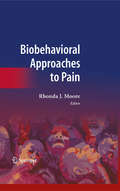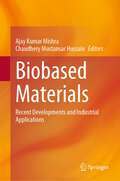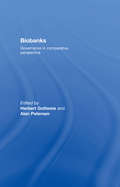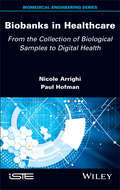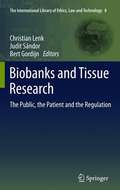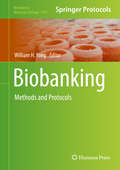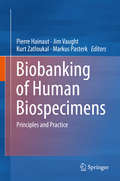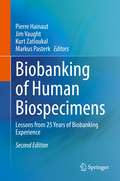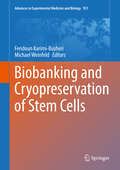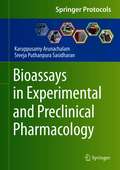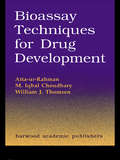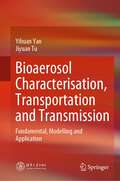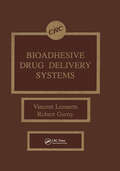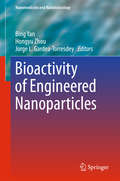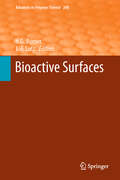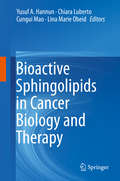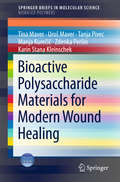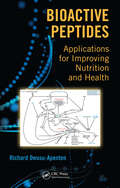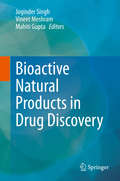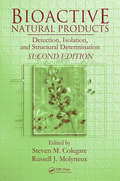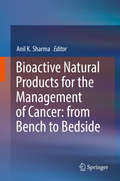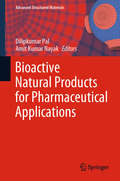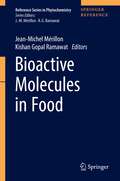- Table View
- List View
Biobehavioral Approaches to Pain
by Rhonda J. Moore J. A. PaicePain is a common symptom, yet it is frequently underevaluated and undertreated. It is difficult to define, describe--and sometimes to prove. It's pain, and suspicions of exaggerations often add further insult to a patients' injuries. Biobehavioral Approaches to Pain translates this highly subjective experience--and its physical, psychological, social, and cultural dimensions--into practical insights key to transforming the field of pain management. This pathbreaking volume synthesizes a rich knowledge base from across disciplines, including neurobiologic, genetic, biobehavioral, clinical, narrative, substance abuse, health services,ethical and policy perspectives, for a deeper understanding of the impact of pain on individual lives and the larger society. Its international panel of contributors highlights special issues and review best practice guidelines, from placebo effects to cancer, Whiplash Associated Disorders to pain imaging to complementary medicine, phantom limb pain to gene therapies to AIDS. Among the topics covered: The distinction between acute and chronic pain: is it clinically useful? Improving clinical assessment of patients with pain. Age and sex differences in pain. The what, how and why of the placebo and nocebo effect Psychosocial and partner-assisted biopsychosocial interventions for disease-related pain Substance abuse issues in pain treatment. The personal, social and economic costs of chronic pain. Biobehavioral Approaches to Pain offers clinical and health professionals, psychologists, as well as specialists in pain management or palliative care, new directions in their ongoing dialogue with patients. Given the prevalence of pain in the general population, it should also interest researchers and students in the field of public health.
Biobased Nanomaterials: Applications in Biomedicine, Food Industry, Agriculture, and Environmental Sustainability
by Shakeel AhmedThis book comprehensively covers various aspects of biobased nanomaterials, including their types, fabrication methods, characterization techniques, and applications in different fields. The book starts with an introduction to biobased nanomaterials, highlighting their significance in various fields due to their unique properties. The first few chapters cover the different types of biobased nanomaterials, their properties, and how they are extracted from various natural sources. The methods of fabrication of biobased nanomaterials are discussed in detail, including the techniques for controlling their size, shape, and composition. It then delves into the characterization of biobased nanomaterials, discussing the different techniques used to determine their properties, including their morphology, size, structure, and composition. The subsequent chapters explore the various applications of biobased nanomaterials in different fields such as environmental applications, wound healing, tissue engineering, food industry, agriculture, sensing technology, biomedical applications, and energy storage devices. The advantages of biobased nanomaterials over traditional nanomaterials are highlighted, including their biodegradability and sustainability. The environmental concerns associated with biobased nanomaterials, as well as the health and safety concerns, are also discussed. The book concludes by looking at the prospects of biobased nanomaterials and how they can contribute to sustainable development. Overall, the book is an informative and comprehensive book that provides a thorough understanding of biobased nanomaterials and their various applications. It is a valuable resource for researchers, students, and professionals in various fields such as materials science, chemistry, biology, and environmental science. alike.
Biobased Materials: Recent Developments and Industrial Applications
by Ajay Kumar Mishra Chaudhery Mustansar HussainThis book discusses the extraction, purification, modification, and processing of biobased materials and their various industrial applications, across biomedical, pharmaceutical, construction, and other industries. It includes contributions from experts on hybrid biopolymers and bio-composites, bioactive and biodegradable materials, bio-inert polymers, natural polymers and composites, and metallic natural materials. Therefore, this encyclopedia is a useful reference for scientists, academicians, research scholars, and technologists. Major challenges of biobased materials are their efficient development, cost-effective, and green & environment friendly production/applications. This encyclopedia answers these challenges to professionals and scientists for proper utilization of biobased materials. It presents the recent practices of biobased materials technology in different scientific and engineering domains. It helps the bounded industrial outcomes to reach the general readership of different domains. This encyclopedia bridges the technological gaps between the industrial and academic professionals and the novice young students/scholars. The interdisciplinarity of this encyclopedia makes it unique for a wide readership. The topic of biobased materials is currently popular in the scientific community, working in such following areas as Recycled materials, Renewable materials, Materials for efficiency, Materials for waste treatment, Materials for reduction of environmental load, Materials for easy disposal or recycle, Hazardous free materials, Materials for reducing human health impact, Materials for energy efficiency, Materials for green energy, etc. This is a relatively hot topic in materials science and has strong demands for energy, material and money savings, as well as heavy contamination problems, despite that the area of biobased materials belongs to most important fields of modern science & technology, no important encyclopedias have been published in the area of “biobased materials”
Biobanks: Governance in Comparative Perspective
by Alan Petersen Herbert GottweisIn recent years, a number of large population-based biobanks - genetic databases that combine genetic information derived from blood samples with personal data about environment, medical history, lifestyle or genealogy - have been set up in order to study the interface between disease, and genetic and environmental factors. Unsurprisingly, these studies have sparked a good deal of controversy and the ethical and social implications have been widely debated. Biobanks: Governance in Comparative Perspective is the first book to explore the political and governance implications of biobanks in Europe, the United States, Asia, and Australia. This book explores: the interrelated conditions needed for a biobank to be created and to exist the rise of the new bio-economy the redefinition of citizenship accompanying national biobank developments This groundbreaking book makes clear that biobanks are a phenomenon that cannot be disconnected from considerations of power, politics, and the reshaping of current practices in governance. It will be a valuable read for scholars and students of genetics, bioethics, risk, public health and the sociology of health and illness.
Biobanks in Healthcare: From the Collection of Biological Samples to Digital Health (ISTE Invoiced)
by Paul Hofman Nicole ArrighiBiobanks ensuring the governance and management of biological resources have become essential entities. The development of biotechnologies, the increased prevalence of biological drugs and the identification of biomarkers associated with molecular classifications of tissue lesions make it essential to have organized access to human biological samples, which have become precious and rare. The digital era and the production of massive data that comes with it have rendered biobanks the guarantors of the reproducibility of experiments and of the overall quality of medical research. Biobanks in Healthcare explores the upheaval linked to the massive deployment of digital health and precision medicine. The future of health biology lies in the deployment of biobanks in fields that have yet to be explored, putting them at the forefront of this extraordinary 21st-century research adventure.
Biobanks and Tissue Research: The Public, the Patient and the Regulation (The International Library of Ethics, Law and Technology #8)
by Bert Gordijn Judit Sándor Christian LenkThe research field of biobanks and tissue research is highly promising. Many projects around the globe are involved in the collection of human tissue and health data for research purposes. These initiatives are driven by the perspective of decisive breakthroughs in the knowledge of the genetic pathways involved in widespread diseases. However, there are considerable ethical and legal challenges to be considered as well. These challenges encompass the use of body material for research purposes, the misuse of genetic and other health data by third parties, trust in science and medicine, concerns regarding privacy, use of genetic data for forensic applications by the state and the police, and regulatory issues. This volume is divided into three parts: the inclusion of the public, the rights of donors and patients, examples and recommendations for the future of tissue research. It presents a comprehensive overview of the most important topics in the field by renowned scholars in medical ethics and biolaw.
Biobanking: Methods And Protocols (Methods in Molecular Biology #1897)
by William H. YongThis volume not only discusses various common biobanking topics, it also delves into less-discussed subjects such as what is needed to start a biobank, training of new biobanking personnel, and ethnic representation in biospecimen research. Other chapters in this book span practical topics including: disaster prevention and recovery; information technology; flora and fauna preservation including zoological fluid specimen photography; surgical and autopsy biobanking; biobanking of bodily fluids; biosafety; cutting frozen sections; immunohistochemistry; nucleic acid extraction; and biospecimen shipping. Written in the highly successful Methods in Molecular Biology series format, chapters include introductions to their respective topics, lists of the necessary materials and reagents, step-by-step, readily reproducible laboratory protocols, and tips on troubleshooting and avoiding known pitfalls.Unique and comprehensive, Biobanking: Methods and Protocols is a valuable resource for novice and practicing biobankers, and for end-user researchers. This book aims to bring new insight into the field and expand on current biomedical biobanking studies.
Biobanking of Human Biospecimens: Principles and Practice
by Pierre Hainaut Jim Vaught Kurt Zatloukal Markus PasterkThis volume is the first comprehensive text on human biobanking, authored by scientists and regulatory officers who have led the field over the past 10 years. It covers biobanking issues and its importance in advancing the field of research in cancer, cardiovascular, metabolic, and other diseases. Biobanks of human specimens have become the cornerstone for research on human health that harnesses the power of "omics" technologies to identify biomarkers for disease susceptibility. Biobanks are an essential component of the development of personalized medicine, which relies on the molecular analysis of biospecimens that are truly representative of individuals and of diseases. Over the past decade, biobanking has been the focus of major investments and developments aimed at developing appropriate infrastructure, methods, networking practice and evidence-based pre-analytical procedures. This volume explores topics including specimen storage, protocol design, specimen collection, pre-analytical processing and preservation, long-term storage, retrieval and separation, and distribution to analytical laboratory platforms. These activities are extremely complex and are essential for biomedical and biotechnological developments and this text provides critical information about biobanking for the development of future forms of medicine.
Biobanking of Human Biospecimens: Lessons from 25 Years of Biobanking Experience
by Pierre Hainaut Jim Vaught Kurt Zatloukal Markus PasterkOver the past 25 years, biobanks of human specimens have become a cornerstone for research on human health and have empowered the “omics “revolution that characterizes biomedical science in the XXIst Century. Today, biobanking of human specimens is a critical component of the interface between clinical practice and translational research, supporting the discovery and validation of new biomarkers of disease etiology, risk, early detection, diagnosis, prognosis, prediction and relapse. With the development of personalized medicine, biobanking of cryopreserved specimens has become standard practice in order to investigate genetic, transcriptomic, proteomic, metabolomics and immunological biomarkers useful to inform caregivers for therapeutic decisions. Data generated from biobanked specimens represent a rapidly growing and highly valuable resource, participating in the emergence of Big Data Medicine. With the development of large computing capabilities and artificial intelligence, data associated with biobanked specimens constitute a unique resource for the discovery and validation of new biomarkers and therapeutically actionable targets. Interconnecting, interoperating and sharing this data have become major issues for national health systems, raising enormous stakes as well as major societal, legal and cybersecurity challenges in terms of compliance with the protection of personal sensitive information. This book project is the second part of an initiative launched in 2012 to produce a published corpus of knowledge encompassing all aspects of human biobanking as a central practice for research and medicine. The first volume, published in 2017, is entitled: Human Biobanking: Principles and Practice. This first volume compiled a series of high level contributions overseeing the main developments that carried the progression of human biobanking as a research and biotechnological field over the past two decades. This new book project will constitute de facto Volume 2 of the same initiative, under the title: Biobanking of Human Biospecimens: lessons from 25 years of biobanking experience. Hence, the two volumes will share the same generic title (Biobanking of Human Biospecimens), with different subtitles, making clear that the two volumes are interrelated while highlighting their specificities in terms of what they actually cover. As a result, the two books are “twins” but can also be used independently of each other.The overarching aim of the two volumes of Biobanking of Human Biospecimens is to provide a published “one-stop shop” for state-of-the-art information on what constitutes the field of human biobanking, from conception of a biobank, standard operating procedures, ethical and societal aspects, governance, networking, interoperability and economic sustainability. This inclusive publication concept meets the needs of a vast readership, including scientists, doctors and technical staffs who are directly involved in biobanking operations, scientists in other disciplines that heavily rely on biobanking (such as genomics or proteomics), stakeholders and policy makers, and of course students for whom biobanking is becoming an important part of the training curriculum. So far, there has been a lack of major textbooks on biobanking. Documentation for biobanking is widely available through numerous publications, regulatory documents published by International or Governmental Agencies, and sets of recommendations essentially accessible through the Internet. However, it is difficult to access a single, top-of-the shelf reference that provides at a glance a large coverage of all aspects of human biobanking. Fulfilling this need is the main origin of the concept for this back-to-back publication project. To our knowledge, there is currently no other publication project with the same breath and scope as this one in the field of biobanking.
Biobanking and Cryopreservation of Stem Cells (Advances in Experimental Medicine and Biology #951)
by Feridoun Karimi-Busheri Michael WeinfeldBiobanking is considered to be one of the ten ideas changing the world with an estimated value of $45 billion by 2025. Despite the challenges, as the climate for innovation in the biobanking industry continues to flourish around the world, it is certain that amazing discoveries will emerge from this large-scale method of preserving and accessing human samples; biobanking is no longer just a place for collecting and storing samples. This book will cover a wide variety of subjects from across the future biobanking spectrum including scientific strategies, personalized medicine, regenerative medicine and stem cell challenges, disease surveillance, population genetics and innovative methods of biobanking.
Bioassays in Experimental and Preclinical Pharmacology (Springer Protocols Handbooks)
by Karuppusamy Arunachalam Sreeja Puthanpura SasidharanThis detailed book explores protocols for a wide array of preclinical pharmacology and toxicology evaluations to be applied to chemical drugs and their development through in vitro, involving tissues and cell lines, and in vivo models, using animals as experimental systems, utilized to conduct pharmacological research. Written for the Springer Protocols Handbooks series, the methodologies included in this collection have been standardized by the authors through extensive use in the lab so that they are ready to be applied in the labs of readers around the world. Authoritative and practical, Bioassays in Experimental and Preclinical Pharmacology aims to assist undergraduate and postgraduate students, research scholars, scientists, and other academicians performing research in the vital field of drug discovery.
Bioassay Techniques for Drug Development
by Atta-ur-Rahman M. Iqbal Choudhary William J. ThomsenThe goal of an activity-directed isolation process is to isolate bioactive compounds which may provide structural leads of therapeutic importance. Whereas the traditional process of drug development is long and expensive, simple and rapid bioassays can serve as the starting point for drug discovery. This book presents a range of "bench top" bioassa
Bioarchaeological and Forensic Perspectives on Violence
by Debra L. Martin Cheryl P. AndersonEvery year, there are over 1. 6 million violent deaths worldwide, making violence one of the leading public health issues of our time. And with the 20th century just behind us, it's hard to forget that 191 million people lost their lives directly or indirectly through conflict. This collection of engaging case studies on violence and violent deaths reveals how violence is reconstructed from skeletal and contextual information. By sharing the complex methodologies for gleaning scientific data from human remains and the context they are found in, and complementary perspectives for examining violence from both past and contemporary societies, bioarchaeology and forensic anthropology prove to be fundamentally inseparable. This book provides a model for training forensic anthropologists and bioarchaeologists, not just in the fundamentals of excavation and skeletal analysis, but in all subfields of anthropology, to broaden their theoretical and practical approach to dealing with everyday violence.
Bioaerosol Characterisation, Transportation and Transmission: Fundamental, Modelling and Application
by Jiyuan Tu Yihuan YanThis book aims to predict and model the transport of bioaerosols, identify their transmission characteristics, and assess occupants’ infection risks. Although existing epidemiological books provide fundamental infection rate of existing diseases, the ability of predicting emerging disease transmission in the air and assessing occupants’ infection risks to the bioaerosols is significantly lacking. This book is considered as a professional book that provides in-depth discussion of the aforementioned issues and provides potential approaches to solve these issues would be highly demanded by readers in this emerging research field. This book offers essential and systematic analysis on the fate of bioaerosols from their release in the air to the final destination in human’s respiratory systems through direct 3D visualizations techniques. It also provides quantifiable method to assess each occupant’s infection risks to the infectious bioaerosols in indoor environments. The readers will gain essential fundamental characteristics of bioaerosols (active time, viability, etc.) and will gain the advanced skills on how to integrate these properties into numerical modeling and assess the occupants’ exposure risks.
Bioadhesive Drug Delivery Systems
by Vincent M. Lenaerts Robert GurnyThis comprehensively written text covers, in-depth, all aspects of bioadhesive systems. Bioadhesive systems are presently playing a major role in the field because of their ability to maintain a dosage form at a precise body-site for a prolonged period of time over which the active principle is progressively released. Included in this book are descriptions of the different mucosae in healthy and pathological situations, a theoretical approach of polymers-mucin interactions, and a comparative description of the methods used to evaluate bioadhesion. Up-to-date reviews of pharmaceutical applications are also given - subdivided according to the route of administration and type of system. It also contains a chapter devoted to the fundamentals of bioadhesion. This reference is an indispensable guide for researchers in the pharmaceutical field as well as academic researchers.
Bioactivity of Engineered Nanoparticles (Nanomedicine and Nanotoxicology)
by Bing Yan Hongyu Zhou Jorge L. Gardea-TorresdeyThis book brings together reviews from international experts who are exploring the biological activities of nanomaterials for medical applications or to better understand nanotoxicity. Topics include but are not limited to the following: 1) mechanistic understanding of nanostructure-bioactivity relationships; 2) the regulation of nanoparticles' bioactivity by means of chemical modification; 3) the new methodologies and standard methods used to assess nanoparticles' bioactivity; 4) the mechanisms involved in nanoparticle-biomolecule interactions and nanoparticle-cell interactions; and 5) biomedical applications of nanotechnology. The book will be a valuable resource for a broad readership in various subfields of chemical science, engineering, biology, environment, and medicine.
Bioactive Surfaces (Advances in Polymer Science #240)
by Jean-Francois Lutz Hans G. BörnerErik Wischerhoff, Nezha Badi, André Laschewsky and Jean-François Lutz Smart Polymer Surfaces: Concepts and Applications in Biosciences; S. Petersen, M. Gattermayer and M. Biesalski Hold on at the Right Spot: Bioactive Surfaces for the Design of Live-Cell Micropatterns; Julien Polleux Interfacing Cell Surface Receptors to Hybrid Nanopatterned Surfaces: A Molecular Approach for Dissecting the Adhesion Machinery; Abigail Pulsipher and Muhammad N. Yousaf Self-Assembled Monolayers as Dynamic Model Substrates for Cell Biology; D. Volodkin, A. Skirtach and H. Möhwald LbL Films as Reservoirs for Bioactive Molecules; R. Gentsch and H. G. Börner Designing Three-Dimensional Materials at the Interface to Biology; Joerg C. Tiller Antimicrobial Surfaces;
Bioactive Sphingolipids in Cancer Biology and Therapy
by Yusuf A. Hannun Chiara Luberto Cungui Mao Lina Marie ObeidThis volume presents information on both the basic and clinical aspects of sphingolipid-metabolizing enzymes in various cancers. The volume also includes discussions of the innovative techniques and approaches for quantitative analysis and imaging that could significantly impact the general understanding of this topic, and the potential benefit of targeting sphingolipid enzymes to develop novel cancer therapeutics. As well, the volume includes a critical examination of the specific pathways and pathobiologies associated with the altered regulation of sphingolipid metabolism as a contributor to the development and/or maintenance of pathological conditions such as cancer.
Bioactive Polysaccharide Materials for Modern Wound Healing (Springerbriefs In Molecular Science: Chemistry of Foods)
by Tina Maver Uroš Maver Tanja Pivec Manja Kurečič Zdenka Peršin Karin Stana KleinschekThis is the first concise book that includes different aspects of naturally-derived components for wound healing. It presents the first exhaustive review of modern techniques in wound dressing development. With a growing, ageing population and the rapid growth of the wound-care market, the authors explore the current trend of bio-based products (active components and host materials) in this field. After a short introduction into modern solutions in wound-care and modern techniques in wound-dressing development, the authors, leaders in the field, explore natural-based components (drugs, extracts, materials etc.); safety and efficiency assessments (biocompatibility, cytotoxicity and in vitro performance etc.); and model films as a platform for the development of new wound dressings.
Bioactive Peptides: Applications for Improving Nutrition and Health
by Richard Owusu-ApentenChronic illnesses, injury, or infections produce a decline in muscle massleading to delayed recovery, more post-treatment complications, longer hospital stays, and higher mortality rates. Therefore, ensuring adequate lean body mass is of major concern in health care. Presenting data from human studies and trials, along with recent research findings
Bioactive Natural products in Drug Discovery
by Joginder Singh Vineet Meshram Mahiti GuptaThis book highlights different natural products that are derived from the plants and microbes that have shown potential as the lead compounds against infectious diseases and cancer. Natural products represent an untapped source of strikingly diverse chemotypes with novel mechanisms of action and the potential to serve as anticancer and anti-infective agents. The book discusses a range of biotechnologically valuable bioactive compounds and secondary metabolites that have been derived from plant and microorganisms from various ecological niches. It also reviews the latest developments in the field of genomics, bioinformatics and industrial fermentation for harnessing the microbial products for commercial applications. In turn, the book’s closing section reviews important biotechnological applications of various natural products. Combining the expertise of specialists in this field, the book’s goal is to promote the further investigation of natural sources for the development of standardized, safe and effective therapies.
Bioactive Natural Products: Detection, Isolation, and Structural Determination, Second Edition
by Steven M. Colegate Russell J. MolyneuxFollowing the successful format of the original, this new edition presents applications of the most recent techniques for the detection, isolation, and structural determination of bioactive natural products. It features new case studies and illustrations that demonstrate applications of techniques covered in the book. Complementing as much as replacing the first edition, most of the contributors are new. The text includes updates on chemical extraction, and NMR-based structure determination, and new contributions on liquid chromatography linked with mass and NMR spectroscopy, dereplication approaches, assessment of source material for natural products and novel bioassay development.
Bioactive Natural Products for the Management of Cancer: from Bench to Bedside
by Anil K. SharmaThis book illustrates the importance of the Natural Biometabolites, which offer a rich reservoir of candidate compounds for drug discovery in the battle against cancer. Recent research and development efforts concerning anti-cancer drugs derived from natural products have led to the identification of numerous candidate molecules that inhibit cancer cell proliferation and metastasis using a variety of mechanisms. Given its scope, the book offers a valuable resource for cancer biologists and general oncologists alike, while also benefitting research professionals in Science, Nursing, Medicine, Biochemistry, Genetics and Bioscience who wish to understand the fundamentals of prognosis and prediction in tumorigenesis. Moreover, the book provides an essential platform for understanding drug resistance mechanisms and combatting the growing menace of multidrug resistance.
Bioactive Natural Products for Pharmaceutical Applications (Advanced Structured Materials #140)
by Amit Kumar Nayak Dilipkumar PalThis book covers the recent innovations relating to various bioactive natural products (such as alkaloids, glycosides, flavonoids, anthraquinones, steroids, polysaccharides, tannins and polyphenolic compounds, volatile oils, fixed oils, fats and waxes, proteins and peptides, vitamins, marine products, camptothecin, piperines, carvacrol, gedunin, GABA, ginsenosides) and their applications in the pharmaceutical fields related to academic, research and industry.
Bioactive Molecules in Food (Reference Series in Phytochemistry)
by Kishan Gopal Ramawat Jean-Michel MérillonThis reference work provides comprehensive information about the bioactive molecules presented in our daily food and their effect on the physical and mental state of our body. Although the concept of functional food is new, the consumption of selected food to attain a specific effect existed already in ancient civilizations, namely of China and India. Consumers are now more attentive to food quality, safety and health benefits, and the food industry is led to develop processed- and packaged-food, particularly in terms of calories, quality, nutritional value and bioactive molecules. This book covers the entire range of bioactive molecules presented in daily food, such as carbohydrates, proteins, lipids, isoflavonoids, carotenoids, vitamin C, polyphenols, bioactive molecules presented in wine, beer and cider. Concepts like French paradox, Mediterranean diet, healthy diet of eating fruits and vegetables, vegan and vegetarian diet, functional foods are described with suitable case studies. Readers will also discover a very timely compilation of methods for bioactive molecules analysis. Written by highly renowned scientists of the field, this reference work appeals to a wide readership, from graduate students, scholars, researchers in the field of botany, agriculture, pharmacy, biotechnology and food industry to those involved in manufacturing, processing and marketing of value-added food products.
